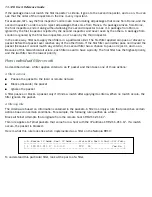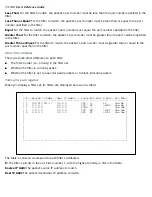
Monitoring Tools 12-119
2.
Select
System Location
and enter the router’s physical location (room, floor, building, etc.).
3.
Select
System Contact
and enter the name of the person responsible for maintaining the router.
System Name, System Location, and System Contact set the values returned by the Netopia R910 SNMP agent
for the SysName, SysLocation, and SysContact objects, respectively, in the MIB II system group. Although
optional, the information you enter in these items can help a system administrator manage the network more
efficiently.
Community strings
The
Read-Only Community String
and the
Read/Write Community String
are like passwords that must be used
by an SNMP manager quer ying or configuring the Netopia R910. An SNMP manager using the
Read-Only
Community String
can examine statistics and configuration information from the router, but cannot modify the
router’s configuration. An SNMP manager using the
Read/Write Community String
can both examine and
modify configuration parameters.
By default, the read-only community string is set to “public” and the read/write community string is blank. You
should change both of the default community strings to values known only to you and trusted system adminis-
trators.
Setting the Read-Only and Read-Write community strings to the empty string will block all SNMP requests to the
router. (The router may still send SNMP Traps if those are properly enabled.)
Previously, if either community string was the empty string, SNMP Requests specifying an empty community
string were accepted and processed.
This change is designed to allow the administrator to block SNMP access to the router, and to provide more
granular control over the allowed SNMP operations to the router.
■
Setting only the Read-Write community string to the empty string will block SNMP Set Requests to the
router, but Get Requests and Get-Next Requests will still be honored using the Read-Only community string
(assuming that is not the empty string).
■
Setting only the Read-Only community string to the empty string will
not
block Get Requests or Get-Next
Requests since those operations (and Set Requests) are still allowed using the (non-empty) Read-Write
community string.
To change a community string, select it and enter a new value.
Caution!
Even if you decide not to use SNMP, you should change the read-only community string and leave the
read/write community string blank. This prevents unauthorized access to the Netopia R910 through SNMP. For
more information on security issues, see
“Suggested security measures” on page 13-123
.
SNMP traps
An SNMP
trap
is an informational message sent from an SNMP agent (in this case, the Netopia R910) to a
manager. When a manager receives a trap, it may log the trap as well as generate an aler t message of its own.
Standard traps generated by the Netopia R910 include the following:
■
An authentication failure trap is generated when the router detects an incorrect community string in a
received SNMP packet.
Authentication Traps Enable
must be
On
for this trap to be generated.
Содержание R910
Страница 1: ...Netopia R910 Ethernet Router for DSL and Cable Modems User s Reference Guide ...
Страница 22: ...4 22 User s Reference Guide ...
Страница 30: ...5 30 User s Reference Guide ...
Страница 122: ...12 122 User s Reference Guide ...
Страница 172: ...A 172 User s Reference Guide ...
Страница 186: ...B 186 User s Reference Guide ...
Страница 200: ...E 200 User s Reference Guide ...
Страница 204: ...F 204 User s Reference Guide ...
















































